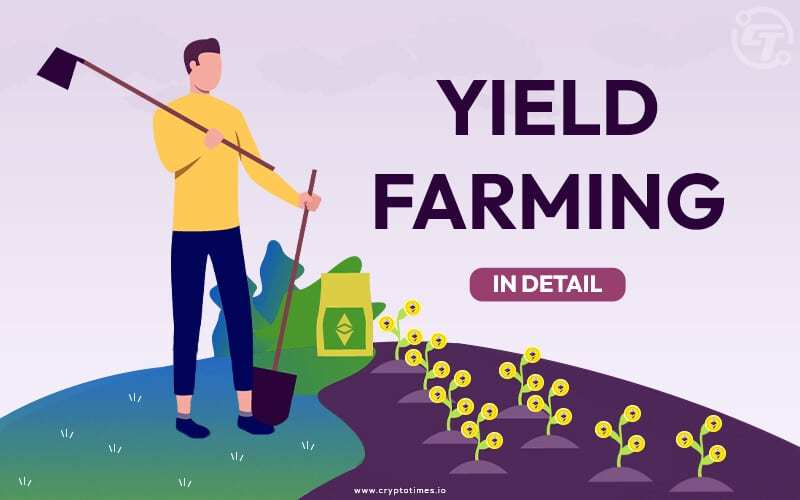A Quick Overview: How Yield Farming Works?
Jan 03, 2024 By Triston Martin
Introduction
Yield farming is an innovative way of earning rewards from cryptocurrencies by providing liquidity to DeFi protocols. It involves depositing digital assets into a pool on a decentralized exchange (DEX) and receiving tokens in return for the liquidity provided. Yield farming has taken off recently with the proliferation of decentralized finance (DeFi) protocols, which are built on Ethereum and other blockchain networks. The potential to earn high returns with relatively low risk makes yield farming attractive to many investors. This guide will explain how yield farming works and how you can earn passive income through this new form of investing.
How Does Yield Farming Work?

Yield farming works by providing liquidity to a decentralized exchange. When users deposit funds into a pool on the DEX, they are rewarded with tokens that can be used in various DeFi protocols. The tokens are typically generated by protocols such as Uniswap and Compound, which use automated market makers to generate ephemeral token pools. Users can earn yield (interest) rewards by providing liquidity to these pools.
These rewards come in two forms: impermanent loss (IL) and transaction fees. Impermanent loss occurs when prices fluctuate between different assets in a pool; as one asset’s price increases relative to another’s, IL is created for those who provide liquidity to the pool. This can be offset, however, by the fees earned from investors trading on the platform.
Yield farming also involves risk. As with any investment, there is a certain degree of risk associated with yield farming; prices can fluctuate quickly, and liquidity providers may find themselves stuck in a pool for much longer than anticipated. Additionally, when providing liquidity to a DEX, users must know how their deposits will interact with other assets in the pool. It’s important to research before investing and understand how different tokens work together within a pool.
Why Should You Try Yield Farming?
The most obvious benefit to yield farming is that it provides an opportunity to earn passive income without taking on traditional investments or financial products. This is particularly attractive to those who are risk-averse or don’t have much capital to invest. But even experienced investors may be tempted by the potential for high returns; given how quickly markets can move, yield farming offers an opportunity to make quick profits in a relatively short amount of time.
Yield farming also has some other advantages over traditional investments. For one, it allows users to diversify their portfolios without owning multiple assets. Users can earn rewards from various tokens simultaneously by providing liquidity to a DEX. Additionally, yield farms can provide access to risky investments that may not be available through traditional financial products; as long as you understand how the protocol works and how your funds will interact with other assets in the pool, you can take advantage of opportunities that may not be available through traditional asset classes.
Finally, yield farming is an effective way to earn rewards while supporting decentralized protocols. As more and more users provide liquidity to DeFi protocols, these networks become stronger, which helps ensure the development of a healthy and vibrant financial ecosystem.
How Do You Get Started With Yield Farming?
The first step in yield farming is to familiarize yourself with DeFi protocols. This includes understanding how different tokens interact in pools on decentralized exchanges, how impermanent loss works, and how the fees generated from trading can contribute to your returns. It’s also important to understand how different tokens interact with each other in DeFi protocols; for example, how Ethereum and Bitcoin can be used to generate yield on Uniswap.
Once you’ve educated yourself on how these protocols work, the next step is to decide which pools you want to provide liquidity. Make sure to research the protocol and understand how different assets interact within it; this will help ensure that you make an informed decision when investing your funds. Additionally, keep an eye out for flash loans and automated market makers that could offer additional returns.
Finally, once you’ve decided which pool(s) you want to invest in, check out how much liquidation risk is associated with each asset class. Liquidation risk is how much of your investment can be lost if the price of an asset drops below a certain threshold. This will help you determine how much risk you’re willing to take on when investing in yield farming.
Conclusion
Yield farming is a great way to earn additional rewards without investing in traditional financial products. By understanding how to yield farming works and minimizing your risks, you can earn rewards from the DeFi space in no time. By providing liquidity to DeFi protocols, users can capitalize on potential arbitrage opportunities and quickly make quick profits.
Additionally, yield farming offers an opportunity to diversify your portfolio without owning multiple assets. Finally, yield farming is an effective way to earn rewards while supporting decentralized protocols and helping ensure their development. This is how to yield farming works and how you can take advantage of it for additional returns. With the right knowledge and strategy, yield farming could be a great option for divers.





